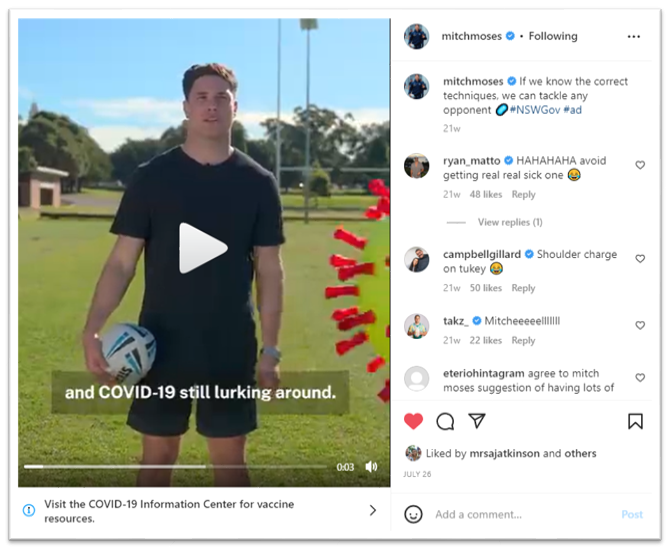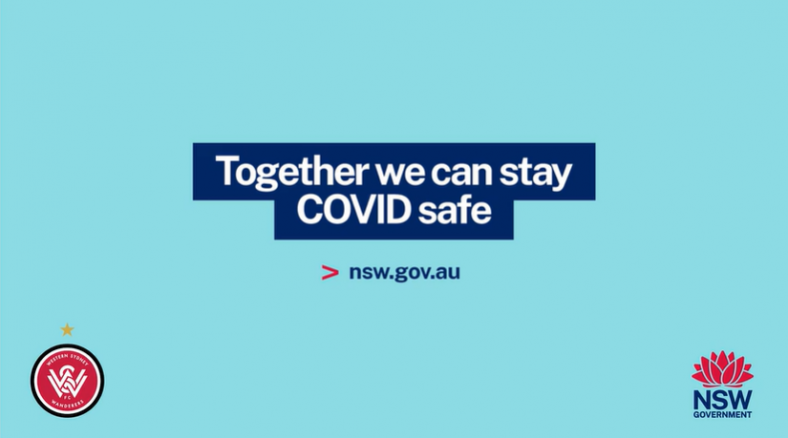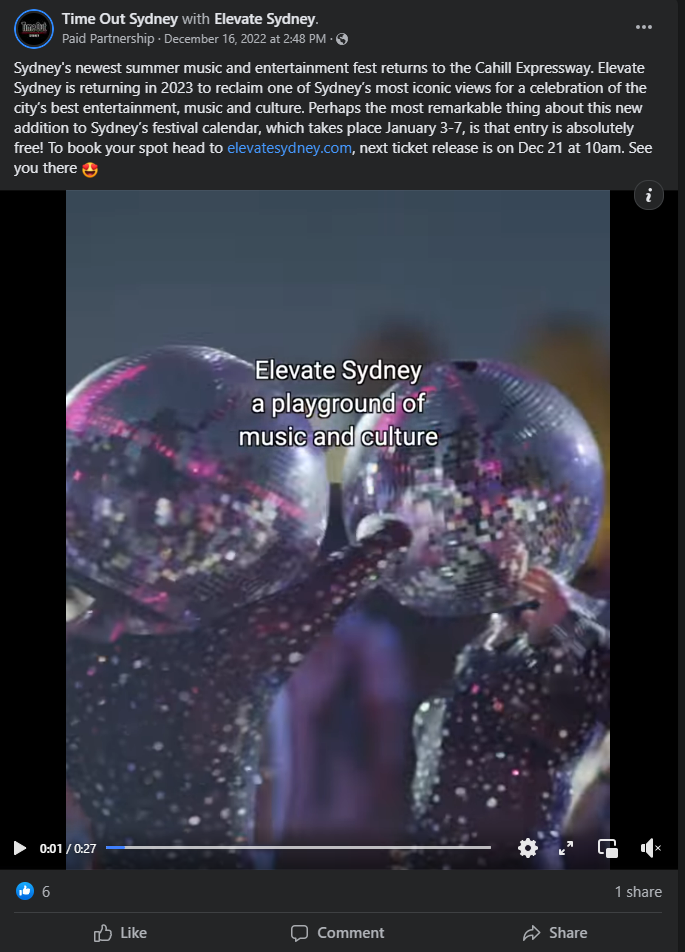Influencers
Find what to consider when defining your strategy, hiring an agency, choosing and paying an influencer, writing a contract, monitoring your campaign and measuring success.
An influencer is a person or people with the ability to influence potential buyers of a product, service or message by promoting or recommending the items on social media. Social media influencers offer the potential to reach new audiences, amplify products or services in market, and build a level of trust if executed ethically.
Recent regulatory focus on influencers and remuneration without ethical declarations means the strategy can come with risk. Understanding how to develop a strategy, leverage an agency, choose and pay the right influencer, ensure ethical disclosure, write a contract, monitor your campaign and measure outcomes are key to a successful influencer campaign.
Before engaging an influencer, it’s important that you:
- check with your legal and/or media team (as some government agencies have a firm “no influencers” stance)
- research the most appropriate influencer for your channels and campaign
- communicate your expectations
- measure and evaluate results
- know the means by which you’ll ensure ethical disclosure of any remuneration (financial or otherwise) .
Define your influencer strategy
Before engaging an agency or influencer, clearly define what your strategy is and whether using an influencer is the best approach to achieving your campaign objectives.
When developing your influencer strategy, consider:
- your objectives and goals and how influencers will help you achieve them
- your target audience/s and how influencers will help you reach them
- your budget
- which platforms your target audience is active on
- what influencers offer that other marketing efforts do not
- whether the influencer’s brand and values align with your organisation and campaign
- how your campaign fits with the influencer’s existing content and other brand associations to ensure there is no conflict of interest or reputational risk to the NSW Government
- verifying the influencer has a legitimate following
- remuneration and how to ensure an ethical disclosure of the relationship
- timelines and volume of content required
- what parameters or boundaries your influencer should work within
- who will approve the influencer's content
- what to do if your chosen influencer comes under fire for their behaviour or content.
Hire an agency
We recommend involving a media agency if you're engaging influencers as part of a campaign.
Some media agencies or platforms are dedicated solely to helping you find the right person for your campaign. These media agencies can help you find the right influencers by:
- applying various filters (for example, psychographic and demographic)
- identifying appropriate personalities
- vetting the influencer for suitability
- detecting fake followers
- providing a quality score
- providing the mechanisms for the ethical disclosure of the relationship
When engaging a media or social media agency, check if they specialise in influencer marketing.
As with any social media campaign, if you’re engaging an agency, it is important you don’t leave it entirely in their hands. To mitigate risk, you should ensure you do your own risk assessments where appropriate throughout the process.
Define success
Your performance indicators will affect the type of influencer you choose, so start by planning your goals.
Your goals may include:
- reach (the total number of people who see your content)
- impressions (the number of times your content is displayed, no matter if it was clicked or not)
- engagement (likes, comments, shares). A good engagement rate is between 1-5%.
- brand awareness
- conversion goals such as downloads, subscribers, purchases, or leads
- improved audience sentiment.
You might also like to set parameters to help achieve these goals. For example, the number of content pieces to deliver or publish.
Choose an influencer
Some agencies are moving away from influencers who are only famous on social media. These agencies are in favour of influencers who have clout outside of social media and are knowledgeable about the campaign they are a part of. Such influencers may include sporting stars, comedians, musicians, entertainers, or television personalities.
You don't have to choose an influencer with millions of followers or an overly curated feed. Micro-influencers can also be effective for engaging with local or niche communities.
Choose an influencer who discloses the partnership clearly and strives to be inclusive, open and apolitical. See the section below on acknowledgement of partnerships for more guidance on this.
Use a social listening tool (such as Meltwater) or an agency influencer database, as well as Google searches, to identify potential influencers, then dig deeper. Investigate each influencer's history and possible risks. Make sure they have a history of publishing a good balance of organic, authentic content that their followers are actively engaged in. Most social listening tools don’t provide a full history, so manual in-platform checks are also advised. Create a shortlist of the influencers you would like to engage or use, keeping in mind not all influencers approached will accept the offer.
Consider the three Rs of influence:
Relevance: Ensure the influencer shares content relevant to your campaign and has an audience that aligns with the people you want to reach.
Reach: Consider how many people you want to reach, and how an influencer will achieve this for you.
Resonance: Understand the amount of engagement an influencer can create with their audience. Consider how content will ensure their audience is interested in the message.
Identify influencers to avoid
All NSW Government campaigns must avoid influencers who:
- engage in risky, unhealthy, illegal or undesirable activities (such as smoking, promoting extreme dieting or taking illicit substances)
- post or express views that are racist, sexist, or homophobic
- bully people
- make jokes at the expense of vulnerable or marginalised people
- are associated with organisations or causes that may bring the NSW Government into disrepute
- are (or have been) involved in public controversies or are openly political
- receive sponsorship or work with brands that conflict with your agency’s values or your campaign’s key message.
- Refuse to meet requirement to ethically and consistently disclose the nature of the influencer relationship.
You can add other criteria to vet influencers that are not suitable for your campaign.
If you think an individual is too risky to be involved in your campaign, play it safe and leave them out.
Use the checklist to help you choose the right influencer for your campaign.
Download the influencer checklist (PDF 73.9KB)
Check the influencer's following
The worth of an influencer is often determined by the size of their following and perceived influence, but there’s more to the story than just size.
Consider using an online tool to check the legitimacy of an influencer's followers. You can use these tools to check if an influencer started off with a large following or has repeatedly gained lots of followers at odd points. These red flags may indicate that the influencer has purchased followers.
You should also check whether the influencer's posts contain authentic comments. If their posts are lacking these (despite the influencer holding a large following), or comments seem illegitimate, the influencer may have purchased their following.
Acknowledgment of partnerships
Influencers must make it known to their audience they are in partnership with the NSW Government when delivering messages to them on their own channels. Audiences should be in no doubt that the influencer is being paid to produce the content or contribute messaging.
Individual influencers, where the inducement to comment is not likely to be clear (such as social media) should recognise a partnership by:
- using in-platform branded content tags
- including an acknowledgement within subtitles or supers on video that references the paid partnership.
- mentioning the NSW Government paid partnership in audio .
Where the influencer campaign is led or shared by the NSW Government and the Waratah logo is prominent in collateral (such as a co-branded message with sporting organisations) the need to reference the paid element of the relationship is lessened only because of the weight of transparency and the use of the Waratah logo.
If you are producing content in partnership with an organisation rather than an individual, the NSW Government Waratah should be included alongside the partner’s brand on an image or video.
NSW Government Visual Identity System

An example of a paid partnership featuring NSW Government branding is a series of videos by the Western Sydney Wanderers football team delivering COVID safe messages. The video end frame screenshot below shows the NSW Government logo on the end frame with the COVID campaign creative and tagline.

For paid partnerships some social media platforms, like Facebook allow a “Paid Partnership with X” acknowledgment to be displayed in the post. The below guideline shows ways of acknowledging paid partnerships and branded content on the major social media platforms.
Facebook and Instagram
A paid partnership post (also known as branded content) uses a ‘with’ label to disclose to users the Page name of the business partner. The Paid Partnership label is applied to the post in the meta data (in grey, next to the timestamp).

If there has been an exchange of value between a NSW Government page and a content creator or influencer, you and the influencer should use the branded content label on your posts. Using this feature allows you to see reach and engagement insights on the influencer's posts.
Read this Facebook and Instagram guide on how to add a branded content tag.
To date, LinkedIn does not offer a tagging function to identify branded content or paid partnerships. In this instance, creators and government pages should use #PaidPartnership in post copy to identify that the post is part of a paid partnership.
Agreed acknowledgements should be captured in the contract with all influencers engaged by NSW Government.
Note that when influencer content is being shown on the NSW Government’s own social media channels, branding should always meet the requirements of the NSW Government Visual Identity System and Branding within Advertising.
Write a contract
Once you have researched influencers and chosen who you would like to engage, work with your legal team to write a contract. You may wish to use this
File
Social Media Guidelines - Influencer contract template (DOCX 371.86KB)as a template. Get approval to issue the contract from your senior executive and alert your media team.
From a social media perspective, a contract for an influencer should include:
- goals, objectives and reporting requirements
- content approval process
- start and finish date of the partnership
- types of posts (for example, composition, quality, branding, disappearing content versus feed, who has creative control of images, and who will produce creative)
- remuneration (if any)
- how the influencer will communicate to the public that they are in partnership with the NSW Government and/or your agency (for example, including #PaidPartnership or tagging your account)
- if and how the influencer is to engage with the media regarding the campaign and their partnership with the NSW Government
- appropriate influencer conduct during and after the campaign
- who owns the content, how long it stays live for, whether you can re-use it and how to credit appropriately. Determine whether organic content should remain live in perpetuity or be removed after an end date, and for paid content to have an end date.
- requirements related to the Advertising Act
- what checks are needed for the partnership (for example, a National Police Check and/or a Working with Children Check)
- what happens if the influencer violates or does not fulfil the contract?
- how the influencer should respond to comments on content and where to access approved responses
- what to do if things don’t go as planned.
The contract should align with the guidance in the Australian Influencer Marketing Code of Practice.
Consider remuneration
The NSW Government doesn't have a standard guide on remuneration for influencers.
Influencers will often provide a rate card to agencies with a price list that matches costs to deliverables. However, there may be an opportunity to provide non-monetary remuneration, for example, experiences or media opportunities. All agreed remuneration must be clearly specified in your contract and a mechanism must exist to ensure this is transparent to audiences. Keep in mind some influencers produce their own creative, while others will not, so you may need to factor in production costs.
The example contract template stipulates how long posts need to live on the feed and when payment will be made. We recommend you use the template when engaging an influencer.
Please review the advertising on social media guidelines, as the NSW Government Advertising Act will apply for paid influencers. You must also include all influencer spend in your expenditure reporting.
Monitor the campaign
Set up social listening and check in with your influencer’s accounts regularly.
Contact the influencer to see how they’re going, especially if people are leaving feedback on their posts that needs to be addressed.
Influencers should engage with posts where appropriate, using advice published here:
Evaluate the campaign
Measure the performance and ROI of the influencer campaign based on the predetermined goals and objectives in your strategy.
Compare your campaign results with your objectives. Report your successes and learnings to provide recommendations for future campaigns. The evaluation framework will help you define and measure the success of your work, in line with global best practice.
If using the paid partnership feature on Meta, you’ll have access to your influencer post reach and engagement metrics.
If you’d like to learn more about successful influencer marketing campaigns from across NSW Government please get in touch and email the Digital Campaigns Team at:
digitalcampaigns@customerservice.gov.au
If you would like to run influencer activity through NSW Gov social channels, contact the NSW Gov Social Team at: social@customerservice.nsw.gov.au